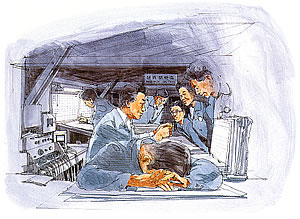Part 3: OMRON's First World-first: The Non-contact (Solid State) Switch
Establishment of OMRON's corporate motto
As the market for automation began to develop, Kazuma turned his attention to creating management policies that would guide the company's expanding operations. In 1956, he took part in a study group organized by Japan's Keizai Doyukai (Association of Corporate Executives) that looked at management's responsibility to society, through which he came to the conclusion that companies should not only pursue profit, but also act as responsible corporate citizens by giving back to the society in which they operate. A new company motto, which was announced with the official establishment of OMRON Corporation on May 10, 1959, reflected Kazuma's-now President Tateisi's-sense of corporate social responsibility:
"At work for a better life, a better world for all."
OMRON's corporate motto symbolizes the company's commitment to improving its employees' quality of life and raising the standard of living of people around the world. Following the motto's establishment, it became customary for employees at every OMRON office to recite the words each morning before work. The motto was also printed on employee nametags to reinforce OMRON's commitment to fulfilling its social responsibility.
As the company's central guiding principle, the motto has remained unchanged to this day. Even as OMRON pursues operations on a global scale, it can be said that the motto is represents the company's spirit and approach to business.
Development of the non-contact switch

One night in 1957, President Tateisi was listening to a transistor radio and began thinking about the cyclotron vacuum tube, which had previously been employed in the development of power line protection devices. He supposed that, by eliminating all the contacts, it would be possible to create a switch that could last through 100 million life cycles. At OMRON's 25th anniversary ceremony in 1958, he challenged his entire team of engineers to develop a non-contact (solid state) switch within the next five years.

A group of young researchers who later came to be known within OMRON as the "Seven Samurai" tackled the problem. They encountered many difficulties: at the time, transistors were only used for radios and wireless systems, and technical literature about other applications was not widely available in Japan. However, they finally succeeded in developing a non-contact switch, allowing OMRON to pioneer automatic control systems that adopted transistor logic circuitry.
Looking back, the idea of using transistors for industrial applications may seem ridiculous, but it illustrates the extent to which OMRON employees stepped up to accept challenges under President Tateisi's 7:3 system (attempt it if there is a 70% chance of success, but be prepared for the 30% chance of failure).
HIGHLIGHT
Quotes from Kazuma 3: "That sounds interesting, try it!"
Looking back at the development of the solid state switch, one researcher who was involved with the project said, "President Tateisi valued a challenge-oriented attitude in his research and production staff. You would frequently hear him say 'That sounds interesting, try it!' whenever someone brought up a new idea. In my day, OMRON was truly filled with optimism and a venture spirit."
